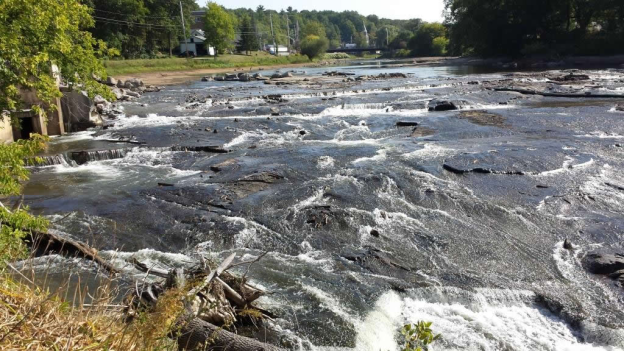In this guest blog, Trout Unlimited’s Ron Rhodes and Rich Redman explain why U.S. Fish and Wildlife Service biologist Madeleine Lyttle was selected as the organization’s 2017 Conservation Professional of the Year.
After Tropical Storm Irene dumped nearly 10 inches of rain on New England and the Northeast in 2011, the resulting flood damage was more severe than any in recent memory. Culverts, bridges, and roads were destroyed, causing a flurry of construction and emergency river channel work that often did more harm than good.
If you had surveyed the damage in the weeks following the storm, you would never have envisioned that in the years ahead, more than 220 miles of native brook trout habitat would be reconnected, following the removal of more than 20 problematic dams and culverts that had prevented fish and aquatic organisms passage for decades.

With Madeleine Lyttle’s help, this dam was removed by a coalition of groups, including the Greater Upper Valley chapter of Trout Unlimited, opening 88 miles of brook trout habitat in Vermont’s White River watershed. (Credit: Trout Unlimited)
But Madeleine Lyttle, a fisheries biologist with the U.S. Fish and Wildlife Service’s Lake Champlain Fish and Wildlife Conservation Office, could see that future, and helped turn the tragedy into a triumph for conservation through her strong guidance and steady hand in the years that followed.

Madeleine Lyttle collects information on the river at this undersized culvert so engineers can redesign a fish-friendly culvert. (Credit: USFWS)
Working hand in hand with Trout Unlimited (TU) chapters from New York, Vermont, and New Hampshire in the Lake Champlain, Hudson River, and Connecticut River watersheds, Madeleine cobbled together a complex array of partners, harnessed more than $1.5 million in grants from FEMA, U.S. Fish and Wildlife Service, the TU “Embrace A Stream” program, and other sources, and leveraged the power of TU’s grassroots network to identify, assess, plan, implement, and monitor aquatic habitat restoration projects.
And so on September 29, TU Director of Volunteer Operations for the national organization, Jeffrey Yates, presented Madeleine with the 2017 National Conservation Professional Award.
“Indeed,” Jeff told the audience, “Madeleine is a hero of mythical proportions among Trout Unlimited chapters in Vermont, New Hampshire, and New York.”

Jeff Yates, Director of Volunteer Operations for Trout Unlimited, presents the 2017 Conservation Professional award to Madeleine Lyttle (Credit: Trout Unlimited)
Thanks to her efforts, there is growing awareness of how removing and replacing dams and culverts is not only good for trout, salmon, and other fish, but is a real benefit to towns and counties in helping withstand future flood events.
One of those communities benefiting from Madeleine’s passion and expertise is in Willsboro, New York, an hour east of the infamous Lake Placid and located on the Boquet River, about a mile upriver from Lake Champlain. The Boquet River was legendary for Atlantic salmon runs prior to 1864, until the Willsboro Dam was constructed to supply power for the Willsboro Pulp Mill. The area would later be identified as a superfund site because of all the discharge dumped into the river by the Mill. Eventually the site was cleaned up, with New York State Department of Environmental Conservation oversight. Then with Madeleine’s guidance, a suite of partners, including Vic Putman with Trout Unlimited, collaborated to have the obsolete dam removed and restore the region’s valuable fisheries.

Willsboro Dam before removal (Credit: USFWS)

Willsboro after removal (Credit: USFWS)
Countless dams and culverts across New England have come tumbling down, with fish returning to their historic waters thanks to Madeleine Lyttle’s years of work – “with lots more to come,” as Jeff noted at our annual meeting. Her technical expertise and guidance are often the difference between a project foundering or moving forward. She reluctantly takes credit, however, and is quick to remind everyone that the work can only be done with partnerships such as those between TU and the Service.


















